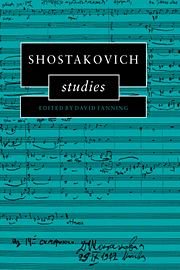Book contents
- Frontmatter
- Contents
- Acknowledgments
- 1 Introduction. Talking about eggs: musicology and Shostakovich
- 2 Public lies and unspeakable truth interpreting Shostakovich's Fifth Symphony
- 3 Form in Shostakovich's instrumental works
- 4 Russian theorists on modality in Shostakovich's music
- 5 The cycle of structure and the cycle of meaning: the Piano Trio in E minor, Op. 67
- 6 Leitmotif in Lady Macbeth
- 7 From Lady Macbeth to Katerina Shostakovich's versions and revisions
- 8 The Golden Age: the true story of the première
- 9 ‘And art made tongue-tied by authority’ Shostakovich's song-cycles
- 10 A debt repaid? Some observations on Shostakovich and his late-period recognition of Britten
- 11 Shostakovich and Schnittke: the erosion of symphonic syntax
- Index
6 - Leitmotif in Lady Macbeth
Published online by Cambridge University Press: 22 October 2009
- Frontmatter
- Contents
- Acknowledgments
- 1 Introduction. Talking about eggs: musicology and Shostakovich
- 2 Public lies and unspeakable truth interpreting Shostakovich's Fifth Symphony
- 3 Form in Shostakovich's instrumental works
- 4 Russian theorists on modality in Shostakovich's music
- 5 The cycle of structure and the cycle of meaning: the Piano Trio in E minor, Op. 67
- 6 Leitmotif in Lady Macbeth
- 7 From Lady Macbeth to Katerina Shostakovich's versions and revisions
- 8 The Golden Age: the true story of the première
- 9 ‘And art made tongue-tied by authority’ Shostakovich's song-cycles
- 10 A debt repaid? Some observations on Shostakovich and his late-period recognition of Britten
- 11 Shostakovich and Schnittke: the erosion of symphonic syntax
- Index
Summary
The Lady Macbeth of Mtsensk District contains one of the most notorious sex scenes in all opera. At the end of Act I, Katerina Izmaylova and Sergey, the new foreman on her family's estate, become lovers, to the accompaniment of a virtuosic orchestral galop complete with additional brass band and culminating, at least in the original 1932 version, in orgasmic trombone glissandi. This musical setting was famously summed up by an American reviewer as ‘pornophony’.
Understandably, perhaps, less attention has been paid to what comes next, which is unfortunate, since the beginning of Act II throws fascinating light on the musical language of the opera. The scene is later the same night. Katerina's father-in-law, the insomniac Boris Timofeyevich, is on watch. He remembers when he was young. He got no sleep then either, but for different reasons … (Ex. 6.1).
Anathema though it may be to opera-lovers, to the Russian musical temperament in general and to the prevailing mode of Shostakovich commentary, I should like to consider this passage in the first instance (and so far as possible) as ‘pure music’. In these terms the music of Example 6.1 is a rhapsodic slow introduction, disturbing and menacing in tone. Its musical language is highly chromatic and not at all easy to explain theoretically. Many harmonic directions are suggested, only for the music to divert away from them. But eventually, at the end of the extract, the opening G minor is reconfirmed as a tonic; and when that happens, the many ambiguities in the harmony resolve into a larger pattern, shown in the analytical sketch on pp. 142–3.
- Type
- Chapter
- Information
- Shostakovich Studies , pp. 137 - 159Publisher: Cambridge University PressPrint publication year: 1995
- 1
- Cited by

